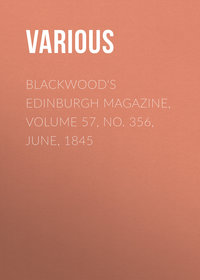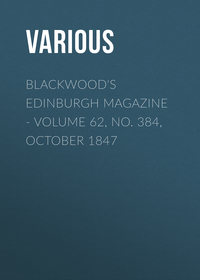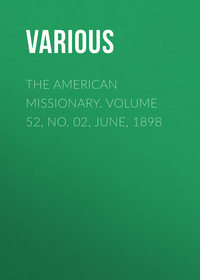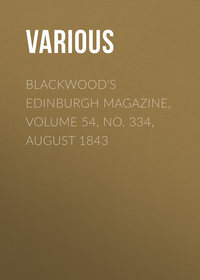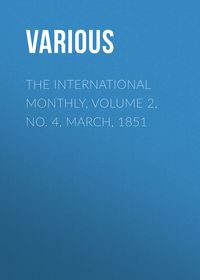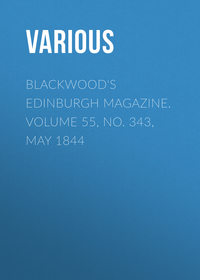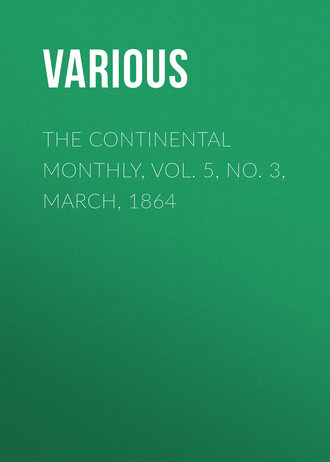 полная версия
полная версияThe Continental Monthly, Vol. 5, No. 3, March, 1864
Romance and poetry have not often been successful in treating of the character and customs of our aborigines, for the elements of true heroism in the savage nature are so exceptional and few, that the red man is a very poor subject for the higher manifestations of art. Cooper and Longfellow alone have come back from this field with the trophies of praise. But Palmer, with a striking originality and a subtle perception of spiritual influences, sees in the effect of Christianity on the 'untutored mind' of the Indian, a theme to inspire his plastic clay. So from this idea he evolves the 'Indian Girl,' standing in an attitude of perfect repose, holding in her right hand a crucifix, on which her eyes are bent pensively in a sweet, absorbing reverie, which shuts out the consciousness of the external world. In the other hand, which hangs listlessly by her side, she barely touches rather than holds a bunch of feathers, evidently gathered to adorn her person, and which she forgets in the contemplation of the story of the Cross. The artist supposes she has found this crucifix, which the early Catholic missionaries were wont to attach to the forest trees, and having heard from some of these zealous teachers an exposition of Christ's mission, the better life has already begun to dawn in her soul, and her whole aspect tells that this mysterious influence is upon her.
The features are Indian, fair and comely—we do not say beautiful, because this term expresses the highest excellence, and ought as a descriptive phrase to be more sparingly used. The face is idealized, as the rules of true art always require, but still preserves its fidelity to the natural type. The form is nude to the waist, the drapery arranged with unrivalled grace, the hair is clubbed so as to reveal the neck and shoulders, while the perfection of contour and the completeness of development satisfy the most critical eye for the study of detail. The 'Indian Girl' forms one of the landmarks in the history of American sculpture.
But Palmer's grand, characteristic work, in which his genius seems to have reached its noblest expression, is the 'White Captive,' which we believe to be one of the most perfect creations of ancient or modern art. It is something more than the nude figure of a surpassingly beautiful woman, bound to the stake, and defying the gaze of her barbarous captors—it is not merely an exciting incident in pioneer life, but it has a grand symbolical meaning that reaches beyond a literal interpretation of the situation.
We see in this statue the contact of civilization with savage instinct, and in the expression of the 'White Captive,' peering through maiden timidity, and rising triumphant above physical fear in a look of intellectual and religious strength, before which the swarthy warrior feels himself in the presence of a superior power—a ruler! As we gaze on in mute admiration, we behold the race of the red man receding westward before that same power pictured in this wonderful face: now the Indian tribes pass the Rocky mountains, they come within the roar of the Pacific, and, growing less and less, they at last vanish away into the uncertain mists of the ocean—a lost people, who have served the purpose for which they were created, and disappeared from our continent to make room for a nobler humanity. It is this melancholy fate, this glorious triumph, that Palmer has recorded in a language more forcible than history, more eloquent than song, more ravishing than the lyre! To define how the statue spreads before you this great vision, eludes the acutest analysis; but there it is, told just as plainly as the Falls of Niagara or the eternal stars tell the omnipotence of God.
The longer one studies this marvellous work, the more he sees to admire, to reflect upon. There is something in the general effect that makes the beholder forget the perfect nudity of the figure, which necessarily grows out of the circumstances of the case, and which is entirely unfelt by the captive in her terrible realization of the peril which surrounds her. Thus two great difficulties that embarrass the execution of undraped statuary are entirely overcome:
1. The nudity is only incidental to the general effect, and the subject seems entirely unconscious of the fact.
2. The nudity is accounted for by the situation—the captive is tied unclad to a tree, to be burned alive, according to Indian custom.
Thus a criticism that has been frequently made (and not unjustly) on the morale of certain works of art, has no application to this.
Of the details of this ideal creation—its matchless finish, the graceful undulations of the perfect form, the firmness expressed in the clenched fingers, the instinctive shudder gathered on the fair brow, the lofty defiance of the eyes and half-parted lips, the radiant beauty of the face—we can only say they live in our memory, but too deep for words. We believe the truth of the artist's conception, that the revengeful savages acknowledged the divinity of her beauty and Christian reliance, and the 'White Captive' went free—the spirit of civilization triumphed!
As a man's character is always more or less associated with his achievements, the reader may wish to learn something of Mr. Palmer as a man. In all kinds of soul-work, there is ever perceptible a certain flavor of the mind which produces it, and the things thus created usually suggest the qualities of the creator. So the works of the sculptor are to some degree the exponents of his character, the expressions of his inner life.
Therefore in Mr. Palmer we should expect moral and intellectual worth of a high order, added to the purest and most exalted motives. He is in spirit a reformer, taking an interest in every measure for the improvement of our race, and sympathizing with every struggle of our aspiring manhood.
The eccentricities, excuses, and conventional affectations of many real and pretended geniuses he entirely eschews, feeling himself one of the people, and laboring for their elevation.
Neither does he deem it any part of genius to neglect his family, forget to pay his butcher's bill, and ignore the claim of his tailor. His ample house and neat atelier, at the north end of Eagle street, in the city of Albany, are the fruit of his patient and inspiring toil—his chisel has won him moderate fortune as well as world-wide fame.
Photographs of the 'Palmer Marbles' are seen in the show windows of Paris, London, and Berlin, while in this country they help to fill the portfolios of the virtuoso, adorning the walls of the parlor and the private gallery.
Though in youth Palmer did not receive an average common-school education, he converses like a man of liberal culture, showing that he belongs to the class of self-made men.
He has never visited the interminable art palaces of Europe, nor studied, in the sense in which that term is used, the 'old masters;' still he has appropriated all the valuable hints to be obtained from the classic models, without regarding them as the ne plus ultra of artistic execution, and therefore to be only imitated, to the exclusion of the higher ideals of an advanced civilization.
He has an intelligible and correct theory in regard to the fidelity of art to nature. For instance, he insists that he should represent, not imitate; and in making a bust of a man, the sculptor should express the higher moods of his subject, and show him with his better qualities brought to the surface. So the forms of nature should be idealized in the direction of their primitive tendency, and thus art help to express that ineffable longing of the soul, that reaching upward for a perfection that is approximated on earth, but never attained. This idealization is like the humor of Dickens, something more than nature in its grotesqueness, yet a stimulated growth of the natural quality. Palmer always takes nature for his model, and then assimilates it to that ideal beauty which dwells in his imagination and sheds a spiritual halo over the creation of his chisel.
Like every true disciple of genius, he feels that he has a mission to perform, and that he is responsible for the influence he exerts on the tastes and æsthetic culture of the people. As you chat with him in his studio, dressed in his blouse and cap, his dark eye glowing with enthusiasm for his art, or sparkling with playful humor, standing before you tall and vigorous, you see in him one of the earnest workers for the elevation of our humanity.
The utilities of the world will take care of themselves: let us foster the beautiful, because, like all divine attributes, man reaches it through striving, and is made better by its contemplation.
Palmer does not look older than forty, and has perhaps not yet attained the fulness of his powers, but has in him the elements of a healthy growth.
Work on, thou almoner of sweetest joys, thou pilgrim in that fairy realm whence come the high ideals of life; work on, striver for the perfect type of beauty and of truth, and in thy progress let the people trace our human nature rising to diviner heights—expanding to sublimer bounds!
CLOUDS
RESPECTFULLY DEDICATED TO PROFESSOR GUYOTHigh and fathomless above us vaults the pure aerial sky,Solemn bends its arch of Beauty round a world where all things die.On the dome through which Earth's swinging, spun of palpitating air,Angel artists fresco vapors into pictures passing fair.No cold canvas of dead color has the Mighty Master given:Trembles with His Infinity the azure vault of Heaven.On and in the lucent background float the ever-changeful forms,Sometimes glowing into glory, sometimes glooming into storms.God's blest seal is on creation; signs and symbols throng the sky,Though too dull to read their meaning droops the stolid human eye.Over mountain, over valley throng the clouds to soothe the sight;Through the dim walls of the city gleam they buoyant, fleeting, bright.Gentle, dreadful, or fantastic—nearer, farther as we gaze;Varied, spiritual, tender, forms and melts the surging haze.'Heavenly secrets' breathe around us—lowly flowers on the sod,Cloudland's curves and grading colors veil the Infinite of God.The Infinite—we shudder! but wild longings through us stealAs we vainly strive to grasp It till our failing senses reel.Ever longing, never grasping, though in tenderness It stoopTo shade the scented cups of flowers, to bend them as they droop.For through infinite gradations pass the changeful hues of light,That the infinite through color may send greetings to the sight.Through ne'er-returning, endless curves, flowers, trees, clouds, mountains pass,That man may see the Infinite through nature's magic glass.Oh, tender stooping! soothing! Infinite Love must beThe cause, aim, end, the burning heart of everything we see.Earth may cover deep her dying, parted hearts chant weary dirge,But we feel death is but seeming in the Cloudland's evening surge.CIRRUSFloating high above the mountains, in the fields of upper air,Multitudinous throng the Cirri, ranged in order, heavenly fair.Rank upon rank in glory lie the transverse, plumy bars;Tranquil beauty rules the union which disorder never mars.Perfect symmetry, obedience, mark their finely chiselled lines—In the highest sphere of being flexile grace with law combines.Now they break in fleecy ripples as innumerably they press;Shines the blue of Heaven between them as they fly the Wind's caress.Millions fleck the face of Heaven, but no two alike are ever:Restless mirror of the Infinite, form seems exhausted never.Are they lambs 'mid Heaven's blue pastures? are they swans with downy breastFloating through that azure ocean round the region of the Blest?Are they snowy wings of Cherubs gathering round the Throne above,As the vesper hymn of Heaven rises to the Eternal Love?Gazing on their wavy ripples, they seem mingling with the sky,Yet the heavenly little islets still innumerable lie.How the fleecy cloudlets glitter as they sail so clear and high!Is light curdling into snowflakes as it streams athwart the sky?Freezing? No—warm and glowing, ambient, changeful, feathery, bright,Rather seem the floating vapors melting into roseate light.With the white flame in their bosoms, and the pure blue depths above,When the sunset rays dart kisses, how they kindle into love!See, with every shaft electric flash the bright hues deeper, higher,Till the chaste and snowy cloudlets fleck the Blue of Heaven with fire.How they flush and how they quiver! how the virgin drifts of snowDrink the sunset's dying passion, catch his ardent parting glow!Love weaves close in chords harmonic all the finely fretted dome,Blue, white, purple, gold, and crimson, fringe, melt, ripple into foam.Thus the angels drape God's footstool with soft vapor, wind, and sun:Does His smile rest on the artists when their pleasant work is done?Do they see Him bend the Heavens, riding swiftly on the clouds,Heat His Heart, and Light the shadow which His inner Glory shrouds?Seraphs, cherubs, thronging round Him, shall our hearts no raptures move?Shall we prove dull links reluctant in the chain of endless love?No. We feel the electric secret flashing through the Perfect Whole,'Bliss eternal' telegraphing upon every faithful soul.CUMULILeave we now the upper regionsWith their wonders pure and high,Gone the barred and fleecy Cirri—Mountain Cumuli storm the sky.High the calmness floats above us,Tears and rain lie far below,As we sail the middle Cloudland,Where the vapors come and go.Throbs a wilder pulse of passion,Stronger individual life,Rapid, energetic motionTells of elemental strife.Nearer seem they to the human,Rearing dizzy forms on high,Than the order-loving CirriBarring the translucent sky.Lovingly they crest our mountains,Hovering o'er them all the day,Copying all the soaring outlinesIn artistic, skilful play;Following close on the horizon,Dip, break, gap, and lofty peak,As to build Earth into HeavenWould the haunting vapors seek.Drifting swiftly through the azure,Chase they shadows over Earth:Flying footsteps, soft and silent,Flit o'er grassy graves in mirth.Shudder not—the bearded harvestQuivers not, so light the tread:Let it glide o'er moss and violet—Would its touch could wake our dead!Piling now, the tossing vapors,With a wild exultant power,Rise in turrets, towers, mountains,Changing with the changing hour.Glittering, gleaming, dazzling, snowy,Heart-tossed shadows in them lie;Broken, scattered, wind-torn, foamy,Haunt they through Earth's panting sky.Luminous jets of boiling vaporTopple into sudden rifts,Open into yawning chasms,Break in tortured whirling drifts,Panting, surging, rocking, reeling,Cradling in their hearts the storm,Spirit, power, passion flashing,Lightning bares each secret form.Banding now in groups colossal,Piling o'er the mountain crest,Sweeping down his rocky summit,Crashing through his wooded breast,Shattering fall his pines and larches,Rain, hail, tumult onward swell,Lightning scathes the shuddering forest,Thunder frights the leafy dell.Sunset fires the whirling vapors,Now they sway and rock in light,Toppling crests fling back the radiance,Through the rifts it glitters bright,Gloomy clouds are ruby kindling,Rippling fringed with molten gold,Rosy streams of color pouring,Through the tempest's blackness rolled.Surging weird in fitful beauty,Every moment fraught with change,Every break and mystic chasmOpening up a Heaven-range:Now the eastern peaks are kindlingGlow as though the Morning's heartThrobbed against them, while the formlessClouds to phantom being start.Thus through storm-tost human bosomsGod oft sends His rays divine;Passionate errors, when forgiven,Lead us on to trust sublime.God rays light through moral tempests,Brings repentance out of crime;'Much forgiven' ploughs the spirit,Former faults as beacons shine.Through our ruins Love is gleaming,Rippling o'er in molten gold,Rosy streams of life are pouringThrough our tempest's blackness rolled.Glittering thus in growing beauty,Every moment fraught with change,Through each rift and shattered chasmWe may see the Heaven-range.Thus the angels build the picturesIn the vext or tranquil skies,Of our changeful human passions,Stormful fall and heaven-won rise.Thus they write in love and pity,Radiant with their heaven-dyes,Lessons for the lost, the erring,Hope for weary, dying eyes.RAIN CLOUDSHigh float the Cirri,Passionless, pure;Wild pile the Cumuli,Never secure;Low sweep the Rain CloudsOver the sky,Glooming the sunshine,Slow trailing by.Mystical regionTypifies Earth—Light in the bosomOf darkness has birth;Magical minglingOf beauty and gloom,Calm follows tempestAs Heaven the tomb.Shrouding the distance,Legions of mistGlide down the riverJoining the listOf the shadowy armyHurrying onOver wide watersTo welcome the sun.Catching his gleaming,Faster they run,Roseate surging,Roll into one;Filling the valley,Luminous haze,Heavenward soaring,Rocks as we gaze;Lifting strange columnsOf light in the air,Weaves golden sunshineFitful and fairThrough the cloud pillarsThrown to the sky,Like the Dream-ladderJacob slept by.Trailing o'er treetops,Shadowing graves,Gloomily weepingWhile the wind raves,Blurring the landscapeRain clouds press on,Lowering on natureWith leaden-hued frown.Sulphurous, lurid,Thunder is near;Sobbings and mutteringsFill us with fear.Palls with wild fringesStream on behind—Death may be ridingThe wings of the wind.Jagged clouds hangingFormless and black,Hurtle the whirlwindFast o'er their track;Fiery flashesScathe the green plain;Cataracts fallingIn torrents of rain.Thunder and lightningCrash through the sky;Whirlwinds are cardingThe clouds as they fly!Nature is reeling,Sin at our heart,Heaven is angered—Well may we start!God throws His shadowInto the gloom;The raindrops have caught it,And break into bloom!His light on Earth's teardropsGems Bliss on her clouds,His rainbow of colorPaints Hope on her shrouds.Tender and lovely,Luminous, fair,Infinite BeautyIs bending through air,Breathing through color,Through Order, through Form,That infinite LoveRules the heart of the storm.Caught in soft meshes,Fractions the light,Gold, green, or ruby,Tremblingly bright.Through the torn chasmsSmiles the lost blue—The wilder the drifting,The deeper the hue.Beauty above us,Beauty around,Clouds, stars gem the heavens,Trees, flowers paint the ground.Rapturous meaningIllumines the whole:God gives us Beauty,For Love is His Soul!High-floating Cirri,Passionless, pure;Wild-piling Cumuli,Never secure;Low-trailing Rain CloudsWith rainbow-lit pall—Softly ye whisperThat Love ruleth all!SKETCHES OF AMERICAN LIFE AND SCENERY
II.—THE CATSKILL MOUNTAINS
Who, in ascending the Hudson River, has not watched for the first glimpse of the Catskills, and followed with delight their gradual development of peak and clove, until, near Hudson, they stood fully revealed, flooded with sunshine, flecked with shadows, or crowned by storm-laden clouds?
This region is noteworthy, not alone from its beauty and incalculable utility, but also from the associations clustering around it through the pen of poets and writers of romance, the brush of the artist, and the memories of thousands of tourists, who have found health and strength for both body and mind upon its craggy heights or beside its numberless wild and beautiful mountain torrents. It comprises the whole of Greene County, a portion of Delaware, and the neighboring borders of Ulster, Schoharie, and Albany. It truly deserves the appellation of 'many fountained,' giving rise to great rivers, such as the Delaware, and one of the main branches of the Susquehanna, and to manifold smaller watercourses, as the Schoharie, Catskill, and Esopus. Unlike the Highlands of Northern New Jersey and Southern New York, and the region of the Adirondacs, its lakes are few and very small. The best known are the twin lakes near the Mountain House, and Shue's Lake, not far from the summit of Overlook Mountain. These are all at a height, approximately, of two thousand feet above the river, and add greatly to the variety and interest of the landscape in their vicinity.
Names among these hills are a commodity so scarce that their paucity presents a serious obstacle to intelligible description. Round Tops and High Peaks are innumerable. We hope, when Professor Guyot completes his cursory survey of heights, made eighteen months ago, he will strive to do as in North Carolina, and supply the deficiency. Nomenclature is a difficult matter, and requires a poet, a poetic man of science, or the imaginative intuitions of a primitive people.
The main range of the Catskills finds its southerly corner in Overlook Mountain, not far from Woodstock, and about seven miles (more or less) west of the Hudson. One ridge extends northerly (a little east, parallel with the river) from twelve to fourteen miles, and then, at the North Mountain, making an obtuse angle, turns to the northwest, and passes through Windham into Schoharie County: the other ridge, starting from Overlook, runs in a westerly direction along the southern border of Greene County, and finally in Delaware sinks into broken hill ranges of less elevation. The space intermediate between these two main ridges is at first narrow, but gradually widens as they diverge from the starting point; its interior (northwesterly) slope is drained by the Schoharie (a branch of the Mohawk) and its tributaries, the East, the West, and Batavia Kills. Singular gaps or cloves intersect the range, affording easy communication with the lowlands bordering its base. Each clove has its own stream, and in the main ones on the river front are found the countless and beautiful waterfalls which constitute the chief characteristic of Catskill scenery. The more primitive rocks of the Highlands, the Adirondacs, and the White Mountains do not offer such numerous and picturesque sheets of falling water as the red sandstone of the Catskills.
Starting from Overlook Mountain, whence the view is said to be magnificent, and proceeding northward, we first reach the Plattekill Clove, up whose steep and wooded cleft winds a wild road, chiefly used for quarrying purposes, and down whose abrupt declivity the Plattekill leaps from crag to crag in a series of fine falls and cascades. The quantity of water during the summer months, except after considerable rain, is small, but the rock formations are very interesting, reminding the traveller of wild passes in the Tyrol. This is perhaps the grandest of all the Catskill clefts, but human ingenuity has here afforded no aid to the sightseer, and strong heads and agile limbs are needed for the enjoyment of its hidden beauties.
The mountain to the north of the Plattekill Clove has two crests, known as High Peak and Round Top. It was long thought to be the loftiest summit of the Catskills, but must now yield to the Windham High Peak or Black Head, 3,926 feet high, and perhaps to other elevations in the same range. Professor Guyot gives its height at 3,684 feet, and that of the Mountain House as 2,245 feet. This mountain has frequently been ascended, although there is no regular path leading to the summit, but the thick growth of wood on the top greatly hinders the satisfactoriness of the view. Between Round Top and the nearest mountain to the north lies the Kauterskill Clove, known preëminently as The Clove, the home of artists and the theme of poets. Its springs are drained by the Kauterskill Creek, a branch of the Catskill, and it is one of the loveliest spots in America. The road through this clove is one of the main arteries to the back mountain country, and, from the summit of the clove, near Haines's sawmill, winds for about three miles to the base, by the side of streams offering fifteen fine falls and cascades in a distance of five miles, and between steep and wooded mountain slopes or rocky crags lifted high in air, now swelling out into the sunlight, and anon curving back into amphitheatres of shadow. The main Kauterskill flows from the twin lakes already mentioned, and just below the Laurel House falls over a precipice of 175 feet, which, with another dash of 80 feet, makes the entire depth of the stream's first grand plunge into the wild ravine 255 feet. A short distance below is the Bastion Fall, and, immediately following, the Terrace Cascade, the united height of the two being certainly not less than 100 feet. These four fine falls are found in an easy walk of three quarters of a mile leading down the ravine from the Laurel House to the Clove road.
The Little Kauterskill flows into the main stream at a short distance below the bridge where the Clove road first crosses that torrent. The ravine through which it flows is incomparably beautiful, with the grand plunge (Haines's Fall or Fawn's Leap) at the head, and the seven graceful cascades, all visible from one projecting table rock, soon after following. Below the above-mentioned bridge are the Dog Fall, the cascade at Moore's Bridge, and the Dog Hole, with its steep cliffs and foaming rapids. At the mouth of the Clove is Palensville, a little manufacturing village, where town-wearied denizens find fresh air and pleasant walks and drives during the summer months. To our taste, however, the summer climate at the various sojourning places, about two thousand feet above the sea level, is far preferable to that at the base of the mountain.


